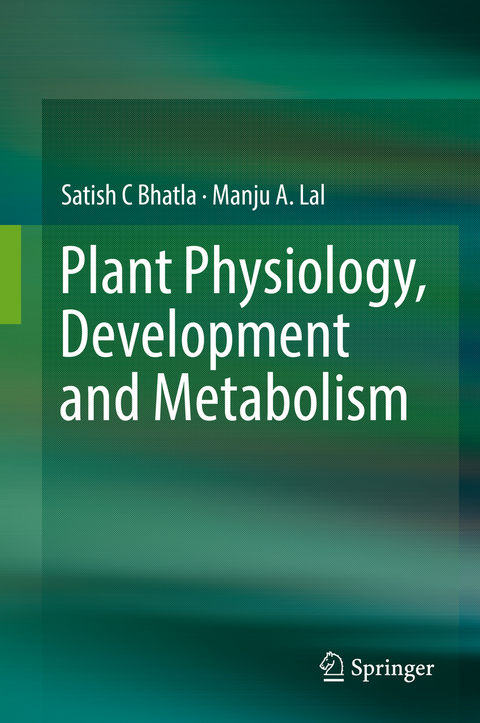
Plant Physiology, Development and Metabolism
Springer Verlag, Singapore
978-981-13-2022-4 (ISBN)
Professor Satish C. Bhatla has served at the Department of Botany, University of Delhi since 1985. After obtaining a specialized Master’s degree in Plant Physiology in 1976 and Ph.D. in 1980, Professor Bhatla undertook postdoctoral training as a Fellow of the Alexander von Humboldt Foundation (Germany), at Heidelberg University of, Freie University Berlin and the University of Freiburg in Germany. He has been teaching and pursuing research in plant physiology for the past 38 years. He has International collaborations with universities in Bonn (Germany), Minsk (Belarus) and Tel Aviv (Israel). Professor Bhatla is a member of the International Society of Plant Signaling and Behavior Steering Committee and an Associate Editor of its journal. He has written more than 90 International research publications. His recent and current areas of research include nitric oxide signaling, oil body mobilization mechanisms, salt stress tolerance mechanisms in plants, seed germination and regulation of adventitious and lateral roots. He is a Fellow of the Indian National Science Academy (India) and has been Dean of the Faculty of Science and Head of the Department of Botany at the University of Delhi. Contact: bhatlasc@gmail.com Dr. Manju A. Lal obtained her Ph.D. in Plant Physiology from the Indian Agricultural Research Institute at New Delhi in 1976. She specialized in abiotic stress in relation to nitrogen metabolism in crop plants. Dr. Manju A. Lal has taught plant physiology to undergraduate students for more than four decades. She retired from her post as Associate Professor at the Department of Botany, Kirori Mal College, University of Delhi in December 2017. Beyond classroom teaching, Dr. Manju A. Lal has also contributed significantly to disseminating information on key topics in plant physiology to undergraduate students through e-learning projects. Contact: lalmanjua@gmail.com
Part I TRANSPORT OF WATER AND NUTRIENTS.- Chapter 1. Plant water relations.- Chapter 2. Mineral nutrition.- Chapter 3. Water and soluble transport.- Part II METABOLISM.- Chapter 4. Concepts in metabolism.- Chapter 5. Photosynthesis.- Chapter 6. Photosynthate translocation.- Chapter 7. Respiration.- Chapter 8. ATP synthesis.- Chapter 9. Metabolism of storage carbohydrates.- Chapter 10. Lipid metabolism.- Chapter 11. Nitrogen metabolism.- Chapter 12. Sulphur, phosphorus and iron metabolism.- Part III DEVELOPMENT.- Chapter 13. Light perception and transduction.- Chapter 14. Plant growth regulators.- Chapter 15. Auxins.- Chapter 16. Cytokinins.- Chapter 17. Gibberellins.- Chapter 18. Abscisic acid.- Chapter 19. Ethylene.- Chapter 20. Brassinosteroids.- Chapter 21. Jasmonic acid.- Chapter 22. Recently discovered plant growth regulators.- Chapter 23. Mechanisms of signal reception and transduction.- Chapter 24. Embryogenesis, vegetative growth and organogenesis.- Chapter 25. Physiology of flowering.- Chapter 26. Pollination, embryogenesis and seed development.- Chapter 27. Fruit development and ripening.- Chapter 28. Seed dormancy and germination.- Chapter 29. Plant movements.- Chapter 30. Senescence and programmed cell death.- Part IV STRESS PHYSIOLOGY.- Chapter 31. Abiotic stress.- Chapter 32. Biotic interactions.- Part V APPLIED PLANT PHYSIOLOGY.- Chapter 33. Secondary metabolites.- Chapter 34. Plant physiology in agriculture and biotechnology.- Glossary.
| Erscheinungsdatum | 13.12.2018 |
|---|---|
| Zusatzinfo | 431 Illustrations, color; 276 Illustrations, black and white; XXXIV, 1237 p. 707 illus., 431 illus. in color. |
| Verlagsort | Singapore |
| Sprache | englisch |
| Maße | 155 x 235 mm |
| Themenwelt | Naturwissenschaften ► Biologie ► Botanik |
| ISBN-10 | 981-13-2022-5 / 9811320225 |
| ISBN-13 | 978-981-13-2022-4 / 9789811320224 |
| Zustand | Neuware |
| Haben Sie eine Frage zum Produkt? |
aus dem Bereich


